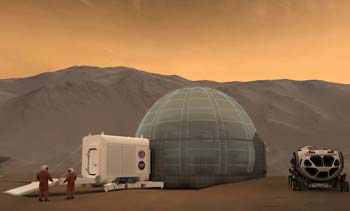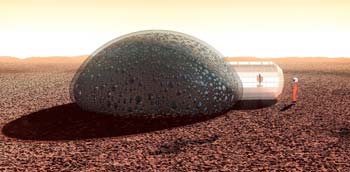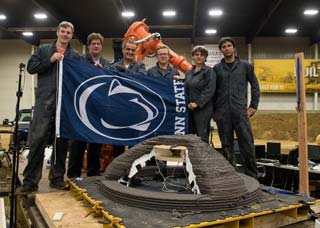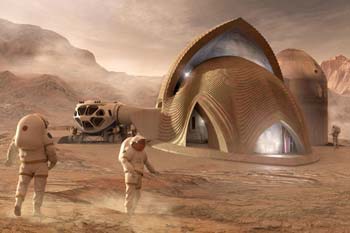
Since the dawn of civilization, mankind has looked to the stars in wonder and excitement. Science and technology are expanding each day, and each day is getting us a step closer to achieving our dream of conquering space. The moon landing marks the first truly great achievement for mankind.
But the next big step for humanity is to colonize Mars. It might sound like science fiction, especially to those who do not keep up with science journals, but we have a solid timeline for establishing a permanent human base on mars by 2054. However, there are many hurdles we have to get through before we get to that point.
In this article, we will explore the very real concept of a human colony on Mars and how 3D printing could help make the dream a reality.
A Little Bit Of History

The concept of 3D printing is not exactly new. It was first proposed or rather introduced by the author Raymond F. Jones in the November of 1950 in a popular science fiction magazine named “Astounding.” However, the development and experimentation with this technology did not start until the eighties.
The first patent holder of the technology was a Japanese scientist named Dr. Kodama, who called it Rapid Prototyping.
Fast-forward to this day, and this technology has refined to a greater extent. 3D printing, also called additive manufacturing, has now become an integral part of scientific discovery.
NASA’s 3D Printed Habitat Challenge

To take advantage of the lower cost of 3D printing, NASA launched a challenge that they called the 3D Printed Habitat Challenge.
This 3-year challenge ranging from 2015 to 2019 asked for the community to figure out how 3D printers and resources found on the red planet could be used to build a sustainable human base on Mars.
The challenge had three different phases to tackle the many challenges of building a base on Mars, such as the freezing temperature and radiation for space. With the innovative Marsha Design, the AI Space Factory based in New York, USA, convinced NASA that 3D printing could, in fact, help colonize Mars.
They came up with an elegant and innovative solution that allows them to create a full four-story building in just under 30 hours on Mars. In fact, there is a smaller model of the design called Tera in New York for anyone who is interested.
The Viability of 3D Printing for Mars Colonization

A voyage to Mars is not possible any time you want. There is a very specific window of launch when the two planets are closest to each other.
And to make matters worse, the window only comes once every two years and two months. This means anybody who is going to Mars will stay there for that long at a minimum.
So, the reality of colonizing the red planet depends entirely on self-sustainability. Unless the inhabitants of the planet can provide for themselves with the limited resources, colonizing Mars is only a dream.
Besides, a spacecraft does not have infinite space. Of course, there will be a certain huge number of resources that will be sent for inhabitants on Mars, but there is still a limit to it. So, sending construction material on each launch to Mars is not a very practical step to colonizing the planet.
With 3D printing technology, the problem of limited resources can be solved quite easily. In fact, with this process, the Mars colony can sustain on its own without any helping hand from Earth. It can use the Martian dirt and soil as raw materials for the construction of houses on Mars.
The major breakthrough in 3D printing was when Made in Space, a space agency on behalf of NASA, installed the first 3D printer on the International Space Station in the year 2016.
This technology can even make Elon Musk’s far-fetched dream of colonizing mars before 2050 a very real thing. In fact, Andrew Rush, the president of Made in Space, said it himself in an Interview with the Observer.
The Reality of 3D Printing Technology

We understand how this all may sound like science fiction to some, but in fact, this technology is already making large ripples in the science community. In the March of 2019,
The European Space Agency used 3D printing to create a rocket engine that tested successfully.
If we look closer to home, 3D printing might just be the key to our future. Since the cost of materials to construct housing is rising dramatically, we need an alternative that costs less. This technology solves the problem quite elegantly.
Since NASA wants to make 3D printed houses on Mars, you can be sure that they will come up with something that will actually work. This concept isn’t very far-fetched, and with the advancement of 3D printing technology, we are closer than we think.
The technology is already here. Scientists are working on it even as we are reading this article. As for me, I firmly believe that houses 3D printed by a robot could one day be the solution to house astronauts on the red planet.
However, getting people to mars is the first hurdle space-geeks have to pull off. Sending robots is one thing, but sending people is something else.
However, AI SpaceFactory is working on perfecting their tech so that they can be ready when people do start going back and forth to Mars.
Also know: 3D printing revocation details.
Final Thoughts
The concept of using 3D printing to colonize Mars does sound a bit far-fetched. However, the science behind it checks out. Believe it or not, we are on the verge of taking a big step for humanity thanks to this technology.
While we are talking about making houses on Mars, the same technology and structure can be used to make more sustainable earthbound structures. The first one was set to open in 2020; however, I haven’t heard anything from them yet.
Up Next: What you need to know about a print server & how does it works?